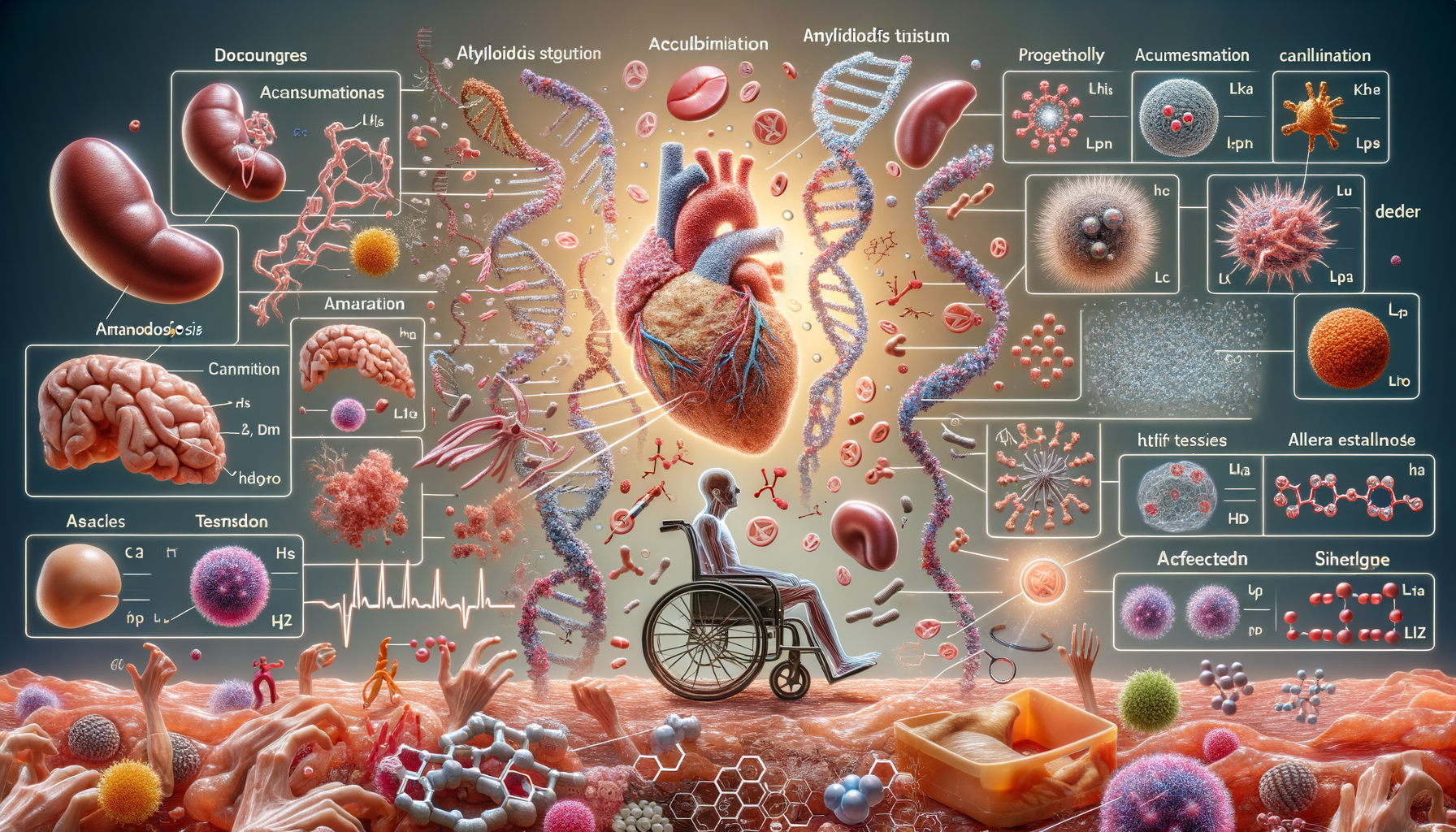What is Amyloidosis?
Amyloidosis is a condition characterized by the abnormal deposition of amyloid proteins in various tissues and organs throughout the body. These proteins can accumulate in different areas, leading to a wide range of symptoms and complications. The condition is not a single disease but a group of diseases, each defined by the type of amyloid protein involved. The most common forms include AL amyloidosis, AA amyloidosis, and hereditary amyloidosis. The diversity of amyloidosis types makes it a complex condition to diagnose and treat, requiring careful medical evaluation.
The causes of amyloidosis vary depending on the type. AL amyloidosis, for instance, is linked to abnormal plasma cells in the bone marrow, similar to those seen in multiple myeloma. AA amyloidosis, on the other hand, is often secondary to chronic inflammatory diseases like rheumatoid arthritis or inflammatory bowel disease. Hereditary amyloidosis is caused by genetic mutations that lead to abnormal amyloid protein production. Understanding these distinctions is crucial for effective management and treatment, as each type may require a different therapeutic approach.
Recognizing amyloidosis can be challenging due to its varied presentation. Symptoms often depend on the organs affected by amyloid deposits. Common manifestations include fatigue, weight loss, swelling, and organ-specific symptoms such as heart failure, kidney dysfunction, or neuropathy. Early detection and diagnosis are essential to prevent irreversible organ damage and improve patient outcomes.
Diagnosis of Amyloidosis
Diagnosing amyloidosis requires a combination of clinical evaluation, laboratory tests, and imaging studies. The process often begins with a thorough medical history and physical examination to identify potential symptoms and risk factors. Blood and urine tests can reveal abnormal proteins or organ dysfunction indicative of amyloidosis. For example, elevated levels of free light chains in the blood may suggest AL amyloidosis, while increased serum amyloid A protein can indicate AA amyloidosis.
Biopsy is a critical diagnostic tool for confirming amyloidosis. A sample of affected tissue, such as fat, bone marrow, or an organ biopsy, is examined under a microscope to identify amyloid deposits. Special staining techniques, such as Congo red staining, can highlight these deposits, which appear apple-green under polarized light. Genetic testing may also be performed to identify hereditary forms of the disease, particularly in patients with a family history of amyloidosis.
Imaging studies, including echocardiography and MRI, can assess the extent of organ involvement and help guide treatment decisions. Newer imaging techniques, such as positron emission tomography (PET) scans with specific tracers, are being developed to improve the detection and monitoring of amyloid deposits. Accurate diagnosis is essential for tailoring treatment strategies and improving patient outcomes.
Treatment Options for Amyloidosis
Treatment for amyloidosis aims to reduce amyloid protein production, manage symptoms, and preserve organ function. The specific approach depends on the type of amyloidosis and the organs affected. For AL amyloidosis, chemotherapy regimens similar to those used in multiple myeloma may be employed to target abnormal plasma cells. Medications such as proteasome inhibitors and immunomodulatory drugs have shown promise in reducing amyloid production and improving survival rates.
In cases of AA amyloidosis, addressing the underlying inflammatory condition is crucial. Anti-inflammatory medications and biologics can help control chronic inflammation and reduce amyloid protein production. For hereditary amyloidosis, liver transplantation may be considered, as the liver is often the primary site of amyloid protein production in these cases.
Supportive care is an integral part of amyloidosis management. This includes medications to manage symptoms such as heart failure, kidney dysfunction, or neuropathy. Dietary modifications, physical therapy, and lifestyle changes can also help improve quality of life for patients. In some cases, clinical trials may offer access to novel therapies that target amyloid deposits directly, providing new hope for patients with this challenging condition.
Living with Amyloidosis
Living with amyloidosis requires ongoing medical care and lifestyle adjustments to manage symptoms and maintain quality of life. Patients should work closely with a multidisciplinary healthcare team, including specialists in hematology, cardiology, nephrology, and neurology, to address the various aspects of the disease. Regular follow-up appointments and monitoring are essential to track disease progression and adjust treatment plans as needed.
Patients with amyloidosis may experience physical and emotional challenges due to the chronic nature of the condition and its impact on daily life. Support from family, friends, and patient advocacy groups can be invaluable in coping with these challenges. Joining support groups or online communities can provide a sense of connection and shared experience, helping patients feel less isolated and more empowered in their journey.
Education is a key component of living with amyloidosis. Understanding the disease, its symptoms, and treatment options enables patients to make informed decisions about their care. Patients should be encouraged to ask questions and seek information from reliable sources to stay informed about advances in research and treatment. By taking an active role in their healthcare, patients can better manage their condition and improve their overall well-being.
Research and Future Directions
Research into amyloidosis is ongoing, with scientists and clinicians working to develop new treatments and improve diagnostic techniques. Advances in understanding the molecular mechanisms of amyloid protein formation and deposition are paving the way for targeted therapies that could revolutionize the management of this condition. One area of focus is the development of drugs that can specifically target and clear amyloid deposits from affected tissues, potentially reversing organ damage and improving outcomes.
Genetic research is also providing insights into hereditary forms of amyloidosis, leading to the identification of new genetic mutations and risk factors. This knowledge is helping to refine genetic testing and counseling for affected families, enabling earlier diagnosis and intervention. Additionally, research into the role of inflammation and the immune system in amyloidosis is uncovering new therapeutic targets and strategies for managing the disease.
Clinical trials play a vital role in advancing amyloidosis research. Participation in these trials offers patients access to cutting-edge treatments and contributes to the development of new therapies that could benefit future generations. As our understanding of amyloidosis continues to evolve, there is hope that new breakthroughs will lead to more effective treatments and improved quality of life for patients living with this challenging condition.




Leave a Reply